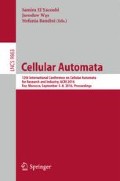Abstract
This study presents an alternative mesh system for the floor-field Cellular Automata model which allows reproducing relevant phenomena observed in high density crowds. Sub-mesh positions are created at the edges and at the corners of adjacent cells to increase the mobility in dense crowds. Special rules are introduced to constrain the use of those additional positions and recreate some behavioral features observed in reality. The model was calibrated and validated using empirical data showing good agreement, while similar results could not be obtained using the standard mesh. Finally it was shown that the introduction of the corner sub-mesh position enhances the quality of the results in case of diagonal motion. The model presented here may allow a more accurate investigation of the crowd accidents occurred in the past and prevent a potential re-occurrence in the future.
Access this chapter
Tax calculation will be finalised at checkout
Purchases are for personal use only
References
Bandini, S., Crociani, L., Gorrini, A., Vizzari, G.: An agent-based model of pedestrian dynamics considering groups: a real world case study. In: 2014 IEEE 17th International Conference on Intelligent Transportation Systems (ITSC), pp. 572–577. IEEE (2014)
Bandini, S., Crociani, L., Vizzari, G.: Pedestrian simulation: considering elderlies in the models and in the simulation results. In: Andó, B., Siciliano, P., Marletta, V., Monteriù, A. (eds.) Ambient Assisted Living. Biosystems & Biorobotics, vol. 11, pp. 11–21. Springer, Switzerland (2015)
Bandini, S., Mondini, M., Vizzari, G.: Modelling negative interactions among pedestrians in high density situations. Transp. Res. Part C Emerg. Technol. 40, 251–270 (2014)
Blue, V., Adler, J.: Emergent fundamental pedestrian flows from cellular automata microsimulation. Transp. Res. Rec. J. Transp. Res. Board 1644, 29–36 (1998)
Federici, M.I., Gorrini, A., Manenti, L., Vizzari, G.: An innovative scenario for pedestrian data collection: the observation of an admission test at the university of milano-bicocca. In: Weidmann, U., Kirsch, U., Schreckenberg, M. (eds.) Pedestrian and Evacuation Dynamics 2012, pp. 143–150. Springer, Switzerland (2014)
Feliciani, C., Nishinari, K.: Phenomenological description of deadlock formation in pedestrian bidirectional flow based on empirical observation. J. Stat. Mech: Theory Exp. 2015(10), P10003 (2015)
Feliciani, C., Nishinari, K.: An improved cellular automata model to simulate the behavior of high density crowd and validation by experimental data. Physica A Stat. Mech. Appl. 451, 135–148 (2016)
Helbing, D., Johansson, A., Al-Abideen, H.Z.: Dynamics of crowd disasters: an empirical study. Phys. Rev. E 75(4), 00046109 (2007)
Henein, C.M., White, T.: Macroscopic effects of microscopic forces between agents in crowd models. Phys. A Statis. Mech. Appl. 373, 694–712 (2007)
Lümmel, G., Rieser, M., Nagel, K.: Large scale microscopic evacuation simulation. In: Klingsch, W.W.F., Rogsch, C., Schadschneider, A., Schreckenberg, M. (eds.) Pedestrian and Evacuation Dynamics 2008, pp. 547–553. Springer, Heidelberg (2010)
Oberhagemann, D.: Static and dynamic crowd densities at major public events. Technical Report March, Vereinigung zur Förderung des Deutschen Brandschutzes (2012)
Sarmady, S., Haron, F., Talib, A.Z.: Simulating crowd movements using fine grid cellular automata. In: 2010 12th International Conference on Computer Modelling and Simulation (UKSim), pp. 428–433. IEEE (2010)
Shimura, K., Ohtsuka, K., Vizzari, G., Nishinari, K., Bandini, S.: Mobility analysis of the aged pedestrians by experiment and simulation. Pattern Recogn. Lett. 44, 58–63 (2014)
Suma, Y., Yanagisawa, D., Nishinari, K.: Anticipation effect in pedestrian dynamics: modeling and experiments. Phys. A 391(1), 248–263 (2012)
Szymanezyk, O., Dickinson, P., Duckett, T.: Towards agent-based crowd simulation in airports using games technology. In: O’Shea, J., Nguyen, N.T., Crockett, K., Howlett, R.J., Jain, L.C. (eds.) KES-AMSTA 2011. LNCS, vol. 6682, pp. 524–533. Springer, Heidelberg (2011)
Was, J., Lubaś, R.: Towards realistic and effective agent-based models of crowd dynamics. Neurocomputing 146, 199–209 (2014)
Weidmann, U.: Transporttechnik der Fussgänger: Transporttechnische Eigenschaften des Fussgängerverkehrs (Literaturauswertung). ETH, IVT (1993)
Yamamoto, K., Kokubo, S., Nishinari, K.: Simulation for pedestrian dynamics by real-coded cellular automata (RCA). Phys. A 379(2), 654–660 (2007)
Yanagisawa, D., Nishi, R., Tomoeda, A., Ohtsuka, K., Kimura, A., Suma, Y., Nishinari, K.: Study on efficiency of evacuation with an obstacle on hexagonal cell space. SICE J. Control Meas. Syst. Integr. 3(6), 395–401 (2010)
Acknowledgments
This work was financially supported by JSPS KAKENHI Grant Number 25287026 and the Doctoral Student Special Incentives Program (SEUT RA) of the University of Tokyo. In addition the authors would like to thank Tokyo Metro Co., Ltd for helping us obtaining the experimental data used for model calibration.
Author information
Authors and Affiliations
Corresponding author
Editor information
Editors and Affiliations
Rights and permissions
Copyright information
© 2016 Springer International Publishing Switzerland
About this paper
Cite this paper
Feliciani, C., Nishinari, K. (2016). An Enhanced Cellular Automata Sub-mesh Model to Study High-Density Pedestrian Crowds. In: El Yacoubi, S., Wąs, J., Bandini, S. (eds) Cellular Automata. ACRI 2016. Lecture Notes in Computer Science(), vol 9863. Springer, Cham. https://doi.org/10.1007/978-3-319-44365-2_23
Download citation
DOI: https://doi.org/10.1007/978-3-319-44365-2_23
Published:
Publisher Name: Springer, Cham
Print ISBN: 978-3-319-44364-5
Online ISBN: 978-3-319-44365-2
eBook Packages: Computer ScienceComputer Science (R0)

